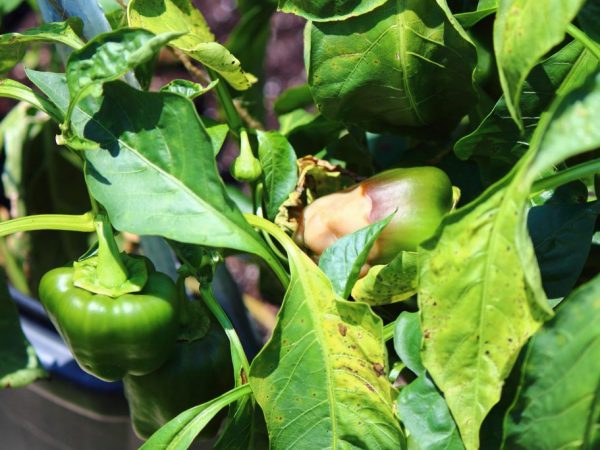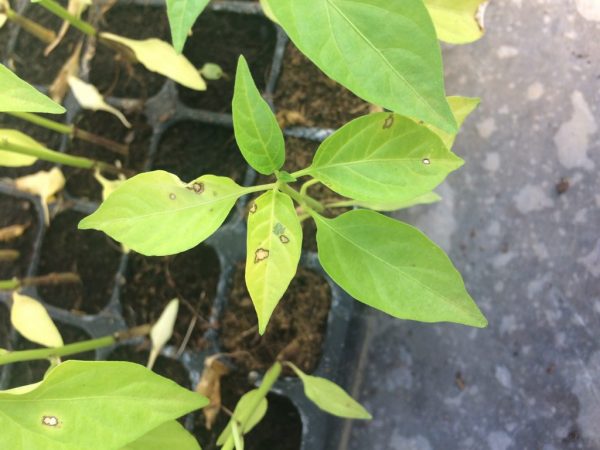Causes of stains on pepper leaves
If changes occur in the appearance of the pepper bush, the culture needs treatment. Often spots appear on the leaves of pepper, associated with both a violation of the growing rules and the development of infectious and fungal diseases.

Causes of stains on pepper leaves
Phytophthora
In nightshades, late blight is a frequent phenomenon. The peak of the disease occurs in the second part of the summer season, when sudden changes in daily temperature begin: it is too hot during the day and rather cold at night.
The disease affects all vegetative parts of pepper bushes, and appears on the foliage in the form of large brown spots. In most cases, spots on bell pepper leaves can be seen on the outside. On the lower part of the leaf blades, under the action of the fungus, a white bloom is formed, which resembles a spider web. The result of late blight disease is dry and fallen leaves.
The phytophthora fungus actively spreads through spores formed on the inside of the sheets.
Control measures
If brown spots appear on the leaves as a result of late blight infection, it is recommended to feed the pepper plantings with fertilizers containing potassium. Such feeding helps to increase the immunity of plants against late blight. Plants also need to be sprayed with preparations containing copper.
Dry spot
Dark, practically black, spots on pepper leaves appear when the plantings are infected with Alternaria. This viral disease leads to the fact that at the initial stage the lower tier of leaves is covered with spots, then the dark colored foci grow and merge with each other, moving to the upper leaf tiers. The result of damage to plants by dry spotting is foliage falling.
The provoking factor contributing to the development of Alternaria is excessive humidity, including frequent mushroom rains and night dews mixed with daytime dry weather.
Control measures
It helps to create protection against dry spot:
- disinfection of the soil and its cleaning from plant residues;
- treatment of plantings with antiviral drugs.
Mosaic
Mosaic is a dangerous viral infection that affects pepper plantings. It primarily affects foliage. The first sign of the development of mosaic on pepper is the appearance on the upper side of the leaf blades of light, from white to milky, spots in the form of a mosaic pattern. Subsequently, the leaf blades become wrinkled.
The mosaic spreads through infected seeds, plant debris in the soil, and is also carried by insects.
Control measures

The disease can affect all seedlings
Among the effective measures to combat mosaics are noted:
- preliminary heat treatment of seed material by heating at a temperature of 70 ° C or disinfection by disinfection with sodium hydroxide with a concentration of 2% or sodium phosphate with a concentration of 10%;
- processing of pepper plantings against insects;
- removal of mosaic-affected seedlings;
- spraying plants with preparations, among the components of which are aloe juice, chrysomal and aphidol.
Bacterial spot
The causative agent of bacterial spotting is a bacterium, which primarily leads to an external change in pepper leaves. The primary sign indicating the defeat of pepper plantings with bacterial spotting is yellow and green spots on young seedlings and dark, almost black, on adult bushes.
At the first stage of the development of the infection, the foci of yellow and green color are small, but over time they grow and become red with a brown and black tint. As a result, foliage curls, dries up and falls off.
The spread of bacteria occurs through damaged areas on the plant and pores on foliage and fruits. Bacterial spotting stops development when humidity drops and rarely appears in regions with cold climates.
Control measures
An effective way to combat bacterial spotting is to regularly spray and decontaminate the seed. Seeds can be disinfected by soaking them in solutions with any medical antibiotic or phytolavine treatment. As a preventive measure, to create protection of plantings from bacteria, they use drugs that contain copper. Also, gardeners often make infusions of garlic (25 g per 5 liters of water) and spray them with plants.
Violation of mineral nutrition
Lack of certain elements of mineral nutrition can also lead to the appearance of spots on the leaves of the pepper.
Phosphorus
With an insufficient amount of phosphorus in the diet of pepper, the leaves become covered with purple dots and become wrinkled. Primary signs are observed on the lower tier of seedlings, but gradually the spotting spreads to the upper rows.
Nitrogen
With a shortage of nitrogen-containing components, yellow spot appears on the foliage. It usually affects young seedlings. The leaf blades dry out, harden and fall off. Subsequently, together with the foliage, the ovaries also fall off.
Potassium
White spots cover the foliage of the pepper with insufficient potassium in the diet. Subsequently, the white spots turn yellow, starting at the edges, resembling burns. Further, the spots become brown, and the leaf blade acquires a dark color.

